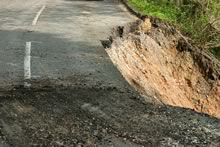

Provided by NOAA’s
National Weather Service
Facts
Landslides occur in all areas of the United States. In a landslide, masses of rock, earth, or debris move down a slope. Landslides may be small or large, slow or rapid. They are activated by:
- storms
- earthquakes
- volcanic eruptions
- fires
- alternate freezing or thawing
- steepening of slopes by erosion or human modification
Debris and mud flows are rivers of rock, earth, and other debris saturated with water. They develop when water rapidly accumulates in the ground, during heavy rainfall or rapid snowmelt, changing the earth into a flowing river of mud or “slurry.” They can flow rapidly, striking with little or no warning at avalanche speeds. They also can travel several miles from their source, growing in size as they pick up trees, boulders, cars, and other materials.
Preparedness
What to do before intense rain storms:
- Become familiar with the land around you.
- Watch the patterns of storm water drainage on slopes near your location, and especially the places where runoff water converges, increasing flow over soil-covered slopes.
What to do during intense rain storms:
- Stay alert and awake.
- If you are in areas susceptible to landslides and debris flows, consider leaving if it is safe to do so.
- Listen for any kind of unusual sounds that might indicate moving debris, such as trees cracking or boulders knocking together.
- If you are near a stream or channel, be alert for any sudden increase or decrease in water flow and for a change from clear to muddy water.
- Be especially alert when driving.
What to do if you suspect imminent landslide danger:
- Contact your local fire, police, or public works department.
- Inform affected neighbors.
- Evacuate.
What to do during a landslide:
- Quickly move out of the path of the landslide or debris flow.
- If escape is not possible, curl into a tight ball and protect your head.
Click for more information regarding land and mud slides from the American Red Cross
